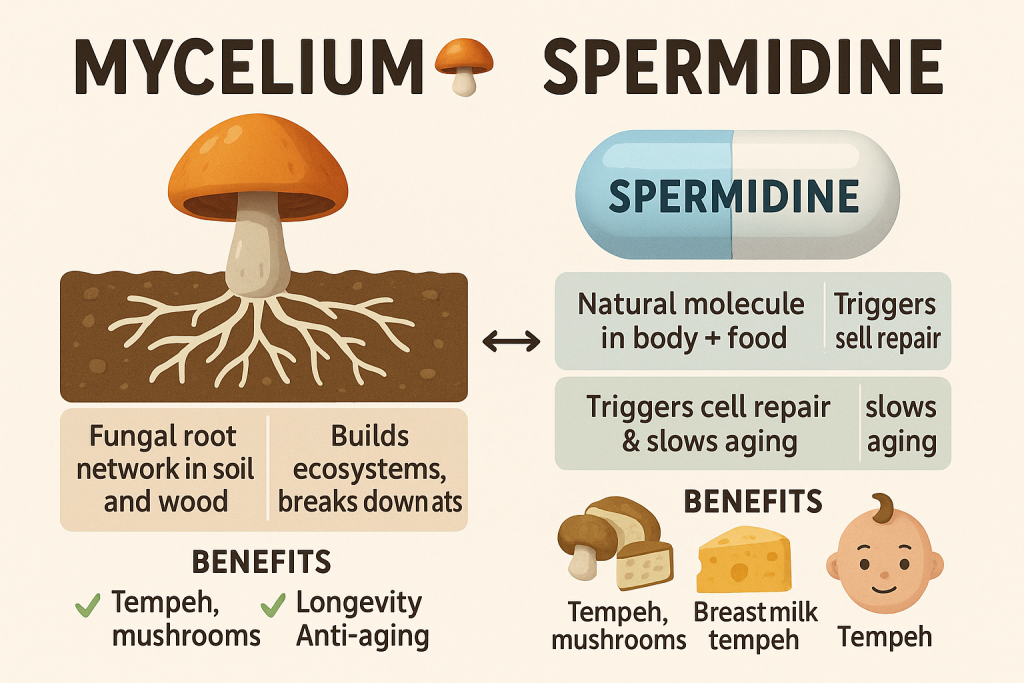
🧬 PART 2: Our Lifespan vs. Potential
🔹 The Human Body is Built to Last
- Genetically, humans are designed to live:
- Up to 120 years (117 for men)
- But most people today live only 60–70 years.
🔹 Other Species Live Closer to Their Natural Lifespan
- Animals in the wild typically live 80%+ of their potential lifespan — only humans fall short.

🌿 PART 3: The 3 Kingdoms of Nutrition
- Plants = Producers of nutrients
- Make vitamins, minerals, and other essential nutrients (except B12).
- Animals = Consumers of nutrients
- Don’t create nutrition themselves.
- Mycelium = The “third forgotten group”
- Neither plant nor animal, but critical to life on land.
🍄 PART 4: What is Mycelium?
🔹 Definition:
- Mycelium is the underground, root-like part of mushrooms.
- It makes up 95% of a mushroom organism.
- The mushroom (what we eat) is just the fruiting body — like an apple on a tree.
🔹 Key Facts:
- Existed for 2.4 billion years.
- Can live forever (no natural aging), thanks to self-repairing, regenerative ability.
- The largest living organism is a 3.5-mile-wide mycelium in Oregon.
🔹 Abilities:
- Produces 60,000+ enzymes.
- Can break down plastics, toxins, radiation — even used in nuclear cleanup.
- More numerous than all plant species combined.
🧫 PART 5: Mycelium as a Super Protein (Ryza Mukar)
🔹 Ryza Mukar (a specific mycelium strain):
- Used in food since the 1960s (cheese, wine, soy fermentation).
- Grows complete protein equivalent to a cow in 24 hours.
🔹 Environmental Benefits:
- Grows in water (almost no water wasted).
- Pulls CO₂ from the air (helps climate change).
- Produces heat that can be used as electricity.
- Zero waste, high efficiency.
🔹 Nutritional Quality:
- Complete amino acid profile (like meat or eggs).
- 100% digestible (perfect PDCAAS = 1.0).
- Higher in leucine & lysine (muscle-building amino acids) than chicken or eggs.
🔹 Global Impact:
- The United Nations called mycelium the most powerful way to solve world hunger and sustainability problems.
💊 PART 6: What is Spermidine?
🔹 Definition:
- Spermidine is a natural molecule (polyamine) found in:
- Human sperm
- Breastmilk
- Some foods (especially fermented and fungal ones)
- Its main job: protect cells, especially DNA, proteins, and growing tissues.
🔹 Its Origins in Biology:
- Named after being first found in semen (protects sperm).
- Also abundant in mother’s milk — crucial for newborn immunity.
🍱 PART 7: Food Sources of Spermidine
- Highest levels found in:
- Tempeh (mycelium-fermented soybeans)
- Mushrooms
- Aged cheeses
- Wheat germ
- The form developed by the speaker contains 70mg per serving — 7–10x more than any known food source.
🧹 PART 8: Spermidine and Autophagy (Cellular Cleaning)
🔹 What is Autophagy?
- Autophagy = “self-eating” = your cells clean out old, damaged parts (like taking out trash).
- Important for anti-aging, cell renewal, immune health.
🔹 Two Key Cell Processes:
| Build Mode | Clean Mode |
|---|---|
| mTOR pathway builds new proteins (from food, sleep, exercise) | Autophagy clears out damaged cells (from fasting, sleep, calorie restriction) |
- Modern humans never fast due to constant eating → autophagy is suppressed → leads to zombie cells (damaged cells that harm others around them).
💡 PART 9: Spermidine is Essential for Autophagy
🔬 Groundbreaking Studies:
- Fasting doesn’t work if spermidine is blocked.
- Rapamycin (drug) doesn’t trigger autophagy unless spermidine is present.
- Spermidine alone can trigger autophagy without fasting.
💥 Key Insight: Spermidine is the real trigger, not just fasting or drugs.
🧪 PART 10: Spermidine Outperforms All Known Anti-Aging Nutrients
- In a study comparing 146 anti-aging compounds (like NMN, resveratrol, astaxanthin), spermidine ranked #1 in effectiveness.
✅ Health Benefits:
- Lowers death risk from heart disease & cancer
- Improves brain function
- Reduces fat storage, increases fat burning
- Boosts immune system
- Grows stronger, thicker hair
- Increases collagen (skin health)
- Improves muscle strength in older adults
- Shown to reduce Parkinson’s symptoms
- May reverse gray hair
👶 PART 11: Impact on Children and Immunity
- Breastfed infants (who get spermidine from mother’s milk):
- Have lower risk of allergies
- Mothers who consume spermidine pass it through milk → improves child immunity
🧠 PART 12: The 12 Longevity Pathways
Spermidine affects all 12 major pathways linked to aging, including:
- Autophagy
- Mitochondrial health
- Inflammation reduction
- Gut health
- DNA repair
- Telomere length (youth marker)
✅ No other nutrient has shown this full coverage so far.
🧴 PART 13: Spermidine Safety
- Safest longevity nutrient tested so far
- No major side effects
- Can be consumed long-term
🧽 PART 14: Mycelium Fiber Cleans Your Body
- Mycelium contains:
- Beta-glucans (boost immunity)
- Chitin (a special fiber)
- Chitin binds to and removes:
- Cholesterol
- LDL
- Toxins
- “Forever chemicals” (PFAS) — found in plastics and very hard to remove
⏳ PART 15: Final Message – Healthspan vs Lifespan
- We’re living longer, but our health is declining faster.
- There’s now a 13-year gap between lifespan and healthspan.
- Spermidine & Mycelium could close that gap — not just keeping us alive, but keeping us healthy.
🎯 Conclusion: What You Should Remember
| Key Takeaway | Summary |
|---|---|
| Mycelium | Ancient fungi roots — grow protein fast, clean toxins, build ecosystems |
| Spermidine | Natural molecule that helps clean cells, slow aging, boost health |
| Autophagy | Cell recycling system — triggered by spermidine, fasting, sleep |
| Why it matters | Longevity, immune strength, fat loss, brain health, and anti-aging |
| Food Sources | Tempeh, mushrooms, fermented foods — or supplements |
| Global Impact | UN sees mycelium as a solution to hunger, climate, and sustainability |